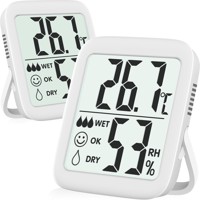This is part of our main guide Which dehumidifier suits me?
What is humidity and why does it matter?
Humidity describes the amount of water in the air. It affects comfort, health and building materials. Air that is too dry irritates eyes and airways; rooms that are too humid promote mold.
Relative vs absolute humidity
Relative humidity indicates what percentage of the maximum possible water content the air currently contains. Absolute humidity specifies how many grams of water per cubic meter are present. For everyday use, relative humidity is more relevant.
Influence of temperature and household activities
Warm air can hold more moisture than cold air. Therefore, relative humidity often drops when a room is heated strongly. Cooking, showering or drying laundry also increase humidity significantly and temporarily.
How to measure humidity correctly
A hygrometer is the standard tool. It shows whether values are in the ideal range or if action is needed.

- Accurate measurement: ±1°C temperature, ±5% humidity
- Large LCD display for easy reading
- 2-pack with magnet & stand - flexible placement
Choosing a hygrometer: what to look for
- Digital or analog: Digital hygrometers are often easier to read.
- Accuracy: Check manufacturer specs and calibrate occasionally.
- Extra features: Some devices store values or display temperature as well.
Placement and frequency of measurement
- Location: Place at eye level in the center of the room, not directly at windows or radiators.
- Frequency: Measure in the morning, evening and after activities like showering or cooking.
- Tip: Occasionally test a hygrometer with a salt test.
Table: recommended target ranges for living spaces
An orientation for healthy values is shown in the table below. According to the German Environment Agency a range of about 40–60% is recommended.
| Room | Recommended range | Notes |
|---|---|---|
| Living room | 40–60 % | Comfortable for daily use |
| Bedroom | 40–60 % | Slightly higher values are acceptable |
| Kitchen | 40–60 % | Short-term higher humidity is normal |
| Bathroom | 50–70 % (short) | Reduce quickly with ventilation |
| Cellar | Preferably under 60 % | High mold risk otherwise |
Recommended ranges per room
The table shows typical ranges. Short-term deviations are uncritical as long as they don’t persist.
When deviations are acceptable
During showering or cooking, values often rise significantly. What matters is that humidity decreases again afterwards.
Actions: lowering humidity
High humidity can quickly lead to mold. There are simple actions that help immediately.
Short-term immediate measures
- Ventilate briefly and intensively: open windows for 5–10 minutes.
- Cross-ventilate: open opposite windows simultaneously.
- Prefer outdoor drying of laundry.
- Use an extractor fan for cooking.
Technical solutions and safety notes
- Use portable dehumidifiers if ventilation is insufficient.
- Use salt-granulate dehumidifiers for small spaces.
- Safety note: If humidity persists or mold appears, always hire a professional.
Actions: increasing humidity
In winter indoor air is often too dry. Targeted measures are necessary for healthy mucous membranes and comfort.
Easy everyday tips
- Place bowls of water on radiators.
- Keep houseplants with moderate water needs.
- Temporarily dry some laundry indoors, but monitor values.
Humidifiers: selection and use
- Ultrasonic or evaporative devices can help.
- Hygrostats prevent over-humidification.
- Clean regularly to avoid microbial growth.
Mold prevention and long-term monitoring
Long-term healthy indoor climate needs routines. Documenting measured values keeps control.
Practical checklist to prevent mold
- Place a hygrometer and check regularly.
- Make burst ventilation a daily routine.
- Keep furniture slightly away from exterior walls.
- Monitor moisture sources (cooking, showering, aquariums).
When to call a professional
- If humidity remains despite ventilation.
- If visible mold appears.
- For unclear causes (e.g., water in walls or cellar).
The WHO on indoor air quality also provides further guidance.
FAQ
What is the ideal humidity in living spaces?
Generally a range of 40–60% is recommended. Slightly higher values are acceptable in the bedroom. The bathroom can be higher briefly but should drop quickly.
How and where should I place a hygrometer?
Place it in the room center at eye level. Not directly on radiators or windows. Measure multiple times a day, especially morning and evening. Check calibration occasionally.
What helps immediately against high humidity?
Ventilate briefly, use an extractor fan or ventilator, dry laundry outdoors. For persistent high humidity or mold, call a professional.
How can I increase humidity without an electric humidifier?
Place water containers, use plants, or small indoor water features. Monitor changes with a hygrometer to avoid over-humidification.
When can too-low humidity be harmful?
It can cause dry mucous membranes, irritated eyes or cough. High humidity is also a mold risk. Aim for 40–60% to balance both risks.
